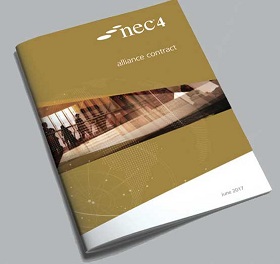NEC4 Alliance contract
Contents |
[edit] Introduction
The construction industry is continually being challenged to deliver improvements in the outcome of projects and programmes of work. Collaboration and better integration of teams are seen as ways to achieve this.
NEC has been at the forefront of the process, creating a suite of contracts that allow all members of the supply chain to be engaged on similar terms and conditions.
[edit] Moving towards alliancing
Demand for better integration of teams continues – particularly for large, highly complex projects and programmes. In these situations, some clients have adopted a fully integrated delivery model known as an 'alliance'.
An alliance is where the client and key members of the supply chain are engaged under a single multi-party contract with shared objectives, risks and rewards. In the UK and internationally, most notably Australia, alliances have delivered better outcomes for both clients and suppliers, with increased efficiency and fewer disputes.
In 2015, the UK government advisory body Infrastructure UK published 'Improving Infrastructure Delivery: Alliancing Code of Practice'. This said there was a clear business case for using alliancing as a procurement route, with increased efficiency being delivered through behavioural and cultural change.
[edit] New NEC4 Alliance Contract (ALC)
Existing NEC contracts are bi-party arrangements onto which an alliance arrangement can be overlaid, such as by using secondary option X12. In 2016, NEC worked with the UK Infrastructure Client Group to publish Guidance on implementing alliancing using NEC3 contracts.
NEC users have requested the development of a distinct alliancing form in which all participants are engaged under a single multi-party contract. This has led to development of the new NEC4 Alliance Contract (ALC), which will initially be published in consultative form to allow industry feedback.
The basis of the contract is that all parties work together in achieving client objectives, and share in the risks and benefits of doing so.
The new ALC is therefore very different from other contracts in the NEC4 suite. However, it follows where possible the same principles and structure of other NEC4 contracts with familiar provisions, proactive management processes and terminology.
[edit] Benefits to users
The potential benefit of using the new ALC is a much deeper collaboration between all project participants, bound by common interests and reduced grounds for dispute.
The contract drives appropriate behaviours in the alliance members through:
- An emphasis on outcomes.
- Creation of a commercial model which rewards expected behaviours.
- Alignment of goals with client and suppliers.
- Use of integrated systems and processes.
- A best-for-project philosophy.
Commercial performance is measured at an alliance rather than individual party level, with reward criteria based on client's objectives. All alliance members are engaged on an open-book basis with project-specific incentive arrangements agreed at the outset.
This article was originally published here on 26 June 2017 by ICE. It was written by Matthew Garratt and Ian Heaphy, NEC4 Contract Board Members.
--The Institution of Civil Engineers
[edit] Related articles on Designing Buildings Wiki
- Articles by ICE on Designing Buildings Wiki.
- ICE Conditions of Contract.
- NEC contracts and collaborative working.
- NEC4.
- NEC4 Design, Build and Operate Contract.
- NEC4 - legal and insurance aspects.
- NEC contract change management systems.
- NEC4 contract creates a procurement alliance arrangement for all stakeholders.
- Partnering.
- Procurement route.
Featured articles and news
The UK's Modern Industrial Strategy: A 10 year plan
Previous consultation criticism, current key elements and general support with some persisting reservations.
Building Safety Regulator reforms
New roles, new staff and a new fast track service pave the way for a single construction regulator.
Architectural Technologist CPDs and Communications
CIAT CPD… and how you can do it!
Cooling centres and cool spaces
Managing extreme heat in cities by directing the public to places for heat stress relief and water sources.
Winter gardens: A brief history and warm variations
Extending the season with glass in different forms and terms.
Restoring Great Yarmouth's Winter Gardens
Transforming one of the least sustainable constructions imaginable.
Construction Skills Mission Board launch sector drive
Newly formed government and industry collaboration set strategy for recruiting an additional 100,000 construction workers a year.
New Architects Code comes into effect in September 2025
ARB Architects Code of Conduct and Practice available with ongoing consultation regarding guidance.
Welsh Skills Body (Medr) launches ambitious plan
The new skills body brings together funding and regulation of tertiary education and research for the devolved nation.
Paul Gandy FCIOB announced as next CIOB President
Former Tilbury Douglas CEO takes helm.
UK Infrastructure: A 10 Year Strategy. In brief with reactions
With the National Infrastructure and Service Transformation Authority (NISTA).
Ebenezer Howard: inventor of the garden city. Book review.
The Grenfell Tower fire, eight years on
A time to pause and reflect as Dubai tower block fire reported just before anniversary.
Airtightness Topic Guide BSRIA TG 27/2025
Explaining the basics of airtightness, what it is, why it's important, when it's required and how it's carried out.
Construction contract awards hit lowest point of 2025
Plummeting for second consecutive month, intensifying concerns for housing and infrastructure goals.
Understanding Mental Health in the Built Environment 2025
Examining the state of mental health in construction, shedding light on levels of stress, anxiety and depression.























